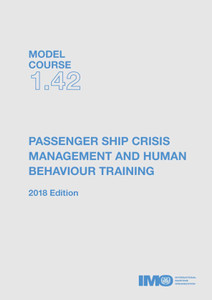
Bridge Resource Management - Model Course 1.22
The
overall
aim
of
this
model
course
is
to
meet
the
mandatory
minimum
standard
of
competence
for
seafarers
for
the
following
competence:
Maintain
a
safe
navigational
watch,
in
particular
bridge
resource
management,
in
column
2,
table
A-II/1
of
the
STCW
Code,
under
the
function
navigation
at
the
operational
level.
This
course
is
theoretical
and
practical,
including
simulator
exercises,
taking
into
account
table
A-II/1
and
the
relevant
parts
of
section
A-VIII/2
of
the
STCW
Code.
The
objective
of
this
model
course
is
to
provide
trainees
with
guidance
and
information
to
obtain
the
knowledge,
understanding
and
proficiency
(KUP)
required
to
achieve
the
objectives
of
the
learning
outcomes.
Trainees
should
demonstrate
the
standard
of
competence
in
bridge
resource
management
as
set
out
in
table
A-II/I
and
paragraph
8
of
section
A-VIII/2
of
the
STCW
Code.
The
trainees
who
have
successfully
completed
the
course
should
be
able
to
successfully
demonstrate
their
competence
to
maintain
a
safe
navigational
watch
at
the
operational
level,
in
particular
their
knowledge
of
bridge
resource
management
principles,
including:
.1
allocation,
assignment
and
prioritization
of
resources;
.2
effective
communication;
.3
assertiveness
and
leadership;
.4
obtaining
and
maintaining
situational
awareness;
and
.5
consideration
of
team
experience.
Foreword
After
the
adoption
of
the
International
Convention
on
Standards
of
Training,
Certification
and
Watchkeeping
for
Seafarers
(STCW),
1978,
the
International
Maritime
Organization
(IMO)
recognized
the
need
to
provide
guidance
to
maritime
academies
and
training
institutes
for
the
development
of
training
courses
that
are
in
compliance
with
STCW
Convention
requirements
for
certification
of
seafarers
and
other
IMO
instruments.
Hence,
the
IMO
model
course
programme
was
introduced
to
provide
guidance
to
support
maritime
training
providers
and
to
assist
maritime
Administrations
responsible
for
the
approval
of
STCW
training
courses
and
maritime
training.
The
IMO
model
course
programme
has
been
a
long-time
success.
IMO
has
developed
several
model
courses
to
help
with
the
effective
implementation
of
the
STCW
Convention;
the
knowledge,
understanding
and
proficiency
(KUP)
requirements
of
the
STCW
Code;
and
other
IMO
instruments.
The
key
to
the
programme’s
success
is
materials
that
adhere
to
the
requirements
of
the
Convention
and
include
industry
best
practices
to
support
seafarers
with
carrying
out
their
duties
on
board.
As
part
of
the
model
courses,
IMO
has
also
developed
guidance
on
their
implementation,
which
may
help
those
less
experienced
facilitators
to
make
each
course
a
success.
While
aiming
to
support
the
uniform
implementation
of
the
requirements
of
the
STCW
Convention
and
Code
and
other
IMO
instruments,
the
model
course
programme
is
designed
to
provide
flexibility
to
allow
training
providers
to
adjust
courses
to
the
needs
of
seafarers
and
trainees,
based
on
their
previous
work,
experience
and
education.
This
model
course
was
validated
by
the
IMO
Sub-Committee
on
Human
Element,
Training
and
Watchkeeping
at
its
ninth
session
(6
to
10
February
2023).
IMO
model
courses
are
for
the
purpose
of
guidance
only
and
are
not
to
be
regarded
as
an
official
interpretation
of
IMO
instruments.
They
can
be
of
assistance
to
Administrations
to
facilitate
the
process
of
approval
of
STCW
course
programmes.
I
wish
training
providers
and
seafarers
well,
and
trust
that
this
model
course
will
support
continued
safe
shipping.
KITACK
LIM
Secretary-General
Foreword
Introduction
Part A: Course framework
Part B: General outline
Part C: Detailed outline
Part D: Instructor manual
Part E: Evaluation and assessment
Appendixes
IMO
As a specialised agency of the United Nations, the International Maritime Organization (IMO) is the global standard-setting authority for the safety, security and environmental performance of international shipping. Its main role is to create a regulatory framework for the shipping industry that is fair and effective, universally adopted and universally implemented.
In other words, its role is to create a level playing field so that ship operators cannot address their financial issues by simply cutting corners and compromising on safety, security and environmental performance. This approach also encourages innovation and efficiency.
Shipping is a truly international industry, and it can only operate effectively if the regulations and standards are themselves agreed, adopted and implemented on an international basis. And IMO is the forum at which this process takes place.
- Number of Pages:
- 0
- Published Date:
- August 2023
- Book Height:
- 0 mm
- Book Width:
- 0 mm
- Author:
IMO
- Publication Date:
- August 2023





